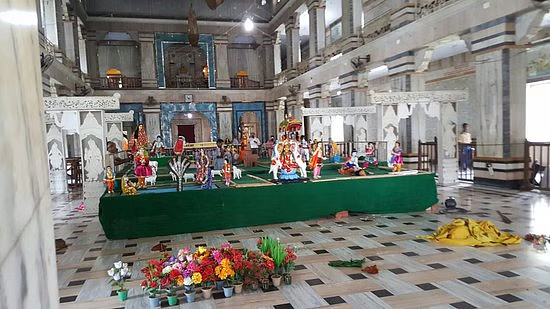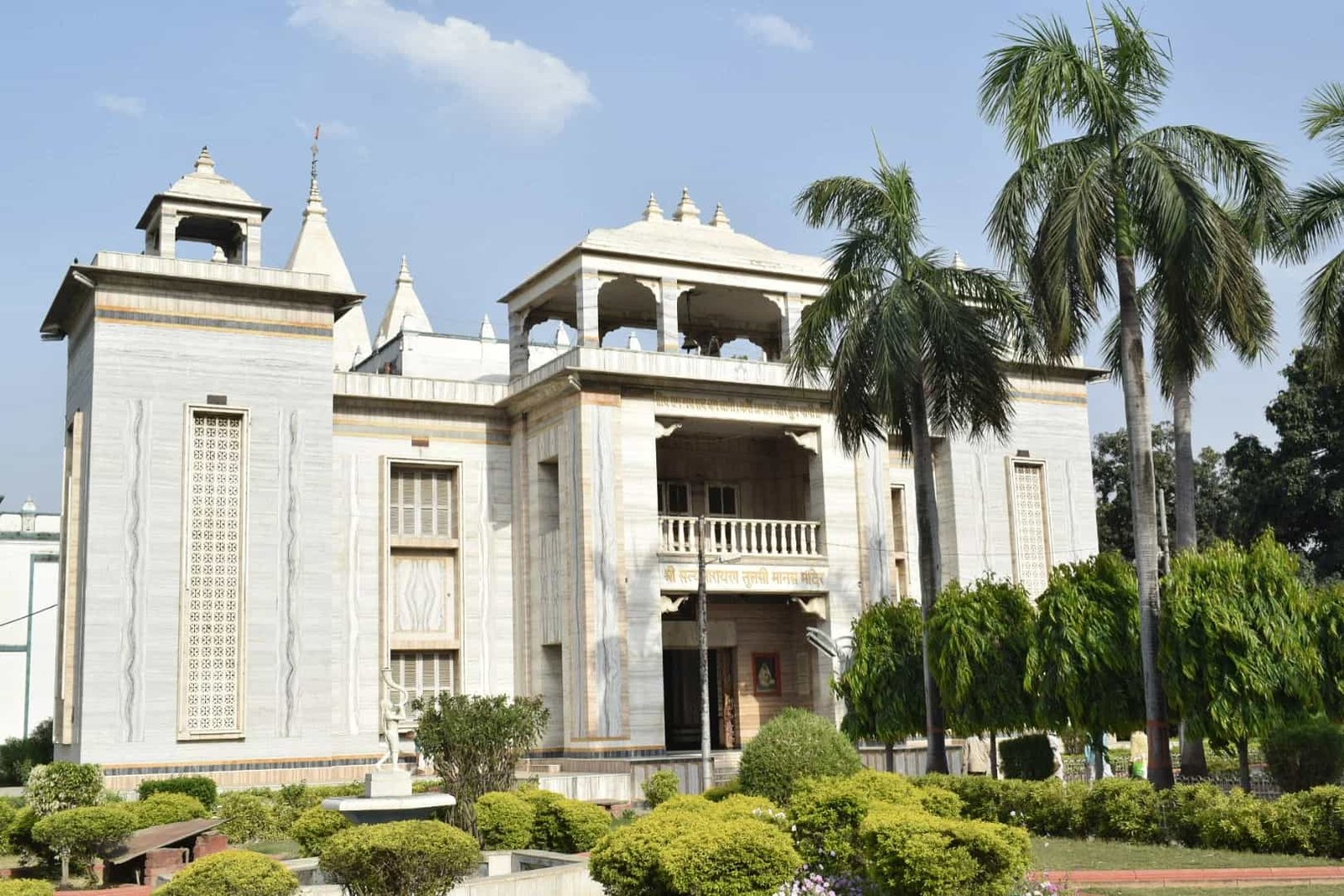Introduction
Varanasi is one of the spiritual capitals of the country, and in it, among all temples, there lies a temple that is certainly adored by all Hindu pilgrims, the Tulsi Manas Temple Varanasi. There are many antiquated temples and, among them, this temple is new, but its origin and purpose are steeped in the history, culture, and devotion to a poet-statesman, Goswami Tulsidas, and his love of Lord Rama.
Tulsidas is said to have written the Ramcharitmanas, the Awadhi Ramayana, in this revered venue. By writing in the local dialect, the poem allowed the average man, who could not read or understand Sanskrit, to learn the story of Lord Rama and his family. So, the Temple is not simply a temple; it is devotion and literature.
History of Tulsi Manas Temple Varanasi
The Tulsi Manas Temple Varanasi was built by the Birla family in 1964. It stands contemporary in date but is linked with centuries of faith: the temple is named after Tulsidas, who, in the 16th century, wrote and is appreciated for the Ramcharitmanas.
This is his monument of loyalty. Every one of the walls of this temple carries his work and message. Tulsidas allowed people to connect to Lord Rama in their own language by writing in Awadhi. So, this temple becomes not only a place of worship but Indian literature.
Location and How to Reach
On Durga Kund Road lies the Tulsi Manas Temple Varanasi. Being close to the Sankat Mochan Hanuman Temple and Durga Mandir allows one to easily see more than one temple in the same vacation.
How to reach:
- From Varanasi Junction railway station – about 7 km.
- From Lal Bahadur Shastri Airport – about 30 km.
- You can travel by rickshaw, cab, or even on foot if nearby.
Architecture of Tulsi Manas Temple, Varanasi
The Tulsi Manas Temple Varanasi is constructed purely of white marble. Its beauty glows in the sun and gives a sense of serene calmness.
The most remarkable aspect is the incised lines of Ramcharitmanas on the temple walls. Lovers of the faith stop to read the lines and feel a spiritual connection to the scripture. The carvings give the temple an appearance of being a sacred book incised in stone.
Spiritual Value of Tulsi Manas Temple Varanasi
The temple is important due to its links with the Ramcharitmanas. Tulsidas’s decision to write in the Awadhi language made the story of Rama accessible to the common man. This endowed the temple with tremendous religious import.
For the visitor, a pilgrimage to the Tulsi Manas Temple in Varanasi feels like entering the world conceived by Tulsidas himself. They believe that chanting sacred shlokas inside the walls of the temple brings peace, divine grace, and religious fervor.
Festivals and Rituals
The place is filled with people praying in the Tulsi Manas Temple at Varanasi. The morning and evening rituals, almost divine experiences in their own right, feature pious priests chanting from the Ramcharitmanas, which imbues a sense of holiness in everybody present.
This place becomes a place of congregation during the festival Ram Navami when people come to hear stories, sing hymns, and watch dramas of the life of Lord Rama. The festival provides an opportunity to celebrate togetherness and common faith with thousands of devotees flocking there.

Tulsi Manas Temple Varanasi vs Other Temples
Varanasi has several famous temples, but stands out from all of them-Tulsi Manas Temple.
- Kashi Vishwanath temple is devoted to the god Shiva, while Tulsi Manas temple is to Lord Rama. Essentially, these two temples demonstrate how different faiths and beliefs have coexisted with one another in Varanasi.
- Another temple is Sankat Mochan Hanuman Mandir, dedicated to Hanuman great devotee of Lord Rama. But then again, Tulsi Manas is more focused on Rama himself. In that sense, these two temples make the spiritual landscape of Varanasi more colourful.
Best Time to Visit
You can visit the temple at any hour. But in case you are looking for the ideal season to pay a visit to the Tulsi Manas Temple in Varanasi, then consider the time from October to March. It is pretty pleasant weather during that period, and it feels a lot better just visiting them.
The festival times are quite special. Ram Navami and Diwali are some of the best times to visit. The temple looked gorgeous at that time, lit with lights and festooned with the spirit of devotion and prayer.
Visitor Guidelines
To prepare for a visit to the Tulsi Manas Temple in Varanasi, please consider the following:
- Operating Hours: 5:30 AM to 12:00 PM and 3:30 PM to 9:00 PM.
- Entry Fee: None.
- Dress Code: Wear something appropriate.
- Behavior: Be silent during worship. No screaming or shouting, please.
- Photography is no harm in capturing the divinity, but do not make it so prominent as to distract others.
Tulsi Manas Temple Varanasi in Literature and Culture
The Ramcharitmanas was more than just a book; it was a revolution. With writing in Awadhi, Tulsidas, however, made religion accessible to the layman in one’s own language. This strengthened the Hindi language and shaped Indian culture.
The Tulsi Manas Temple Varanasi keeps this legacy alive. Its engraved walls are a daily reminder of the impact literature can have on faith.
Legends and Beliefs
Devotees believe that Lord Rama himself blessed this land. Many say that reading or chanting verses of Ramcharitmanas inside the Tulsi Manas Temple Varanasi brings protection and happiness.
Tourist Experience
Visiting Tulsi Manas Temple in Varanasi is more than just prayer. Tourists can:
- Join morning or evening aarti.
- Visit Durga Kund Temple nearby.
- Explore Assi Ghat for cultural activities.
- Shop for local books, idols, and souvenirs.
Tulsi Manas Temple Varanasi in Modern Tourism
The temple draws in most of the tourists of Varanasi at present. Not only are these tourist devotees, but they also include students, scholars, and travelers. However, this place has its own unique identity by linking spirituality with literature, which no other temple has imparted to it.
Conclusion
This temple, Tulsi Manas Temple Varanasi, is no more a marble structure; rather, it is a story of a faith and culture still unheard. All the temple elements from the engravings on the walls to its linkage to Goswami Tulsidas seem to speak of faith and wisdom. Here, in this temple, spirituality is almost palpable with legends entwined. The architecture shows how devotion could be simple and yet beautiful, accessible to every soul. Whether you could be a pilgrim, a wanderer, scholar, or a historian, the Tulsi Manas Temple in Varanasi is filled with history-worthy attractions, a historical testimony that now seems perfectly at home for all times.
Also Read: Bangalore to Mysore Distance: The Ultimate Travel Guide for Every Explorer


